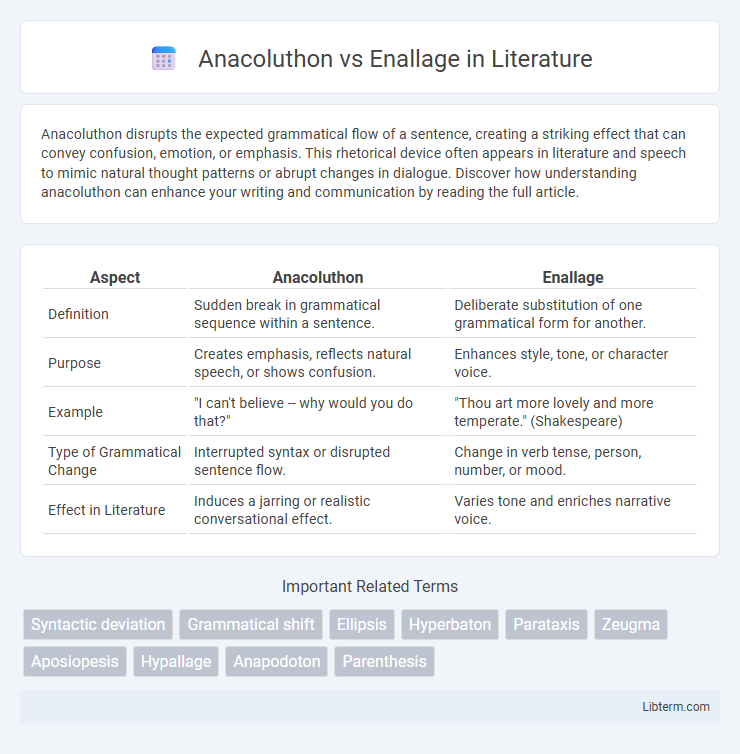Anacoluthon disrupts the expected grammatical flow of a sentence, creating a striking effect that can convey confusion, emotion, or emphasis. This rhetorical device often appears in literature and speech to mimic natural thought patterns or abrupt changes in dialogue. Discover how understanding anacoluthon can enhance your writing and communication by reading the full article.
Table of Comparison
| Aspect | Anacoluthon | Enallage |
|---|---|---|
| Definition | Sudden break in grammatical sequence within a sentence. | Deliberate substitution of one grammatical form for another. |
| Purpose | Creates emphasis, reflects natural speech, or shows confusion. | Enhances style, tone, or character voice. |
| Example | "I can't believe -- why would you do that?" | "Thou art more lovely and more temperate." (Shakespeare) |
| Type of Grammatical Change | Interrupted syntax or disrupted sentence flow. | Change in verb tense, person, number, or mood. |
| Effect in Literature | Induces a jarring or realistic conversational effect. | Varies tone and enriches narrative voice. |
Introduction to Anacoluthon and Enallage
Anacoluthon is a rhetorical device characterized by an abrupt break in the syntactic structure of a sentence, often creating a disjointed or interrupted thought. Enallage involves the deliberate substitution of one grammatical form for another, such as altering verb tense or person, to create emphasis or a stylistic effect. Both devices enhance literary expression by disrupting conventional grammar to engage readers and convey nuanced meaning.
Defining Anacoluthon: Meaning and Usage
Anacoluthon is a rhetorical device characterized by a sudden break in the syntactic structure of a sentence, causing an unexpected shift in grammatical construction. This disruption creates a sense of confusion or emphasis by interrupting the natural flow of thought, often reflecting spontaneous or disjointed speech patterns. Anacoluthon is distinct from enallage, which involves the intentional substitution of one grammatical form for another to convey character or tone.
Understanding Enallage: Definition and Examples
Enallage is a rhetorical device that involves the deliberate substitution of one grammatical form for another, often to create emphasis or stylistic effect. Common examples include using singular verbs with plural subjects or shifting verb tenses within a sentence to convey a nuanced meaning. Understanding enallage enhances literary analysis by revealing how authors manipulate syntax to influence tone and meaning.
Key Differences Between Anacoluthon and Enallage
Anacoluthon involves a sudden break in the grammatical structure within a sentence, creating a disrupted or disjointed flow, whereas Enallage refers to the intentional substitution of one grammatical form for another, such as changing verb tense or person. Anacoluthon often reflects a speaker's hesitation or correction mid-sentence, while Enallage serves as a stylistic device to convey emphasis or character voice. Understanding these distinctions is crucial for analyzing rhetorical techniques in literature and speech.
Historical Context and Literary Origins
Anacoluthon, originating in ancient Greek rhetoric, reflects a deliberate break in sentence structure to convey confusion or emotional intensity, widely used by classical orators like Demosthenes. Enallage, also traced back to Greek literary tradition, involves the substitution of one grammatical form for another to create stylistic effect, found frequently in Homeric epics and later Latin poetry. Both rhetorical devices evolved as key stylistic tools in classical literature, shaping narrative and persuasive techniques in Western literary history.
Common Examples in Literature
Anacoluthon, characterized by a sudden break in sentence structure, is exemplified in Shakespeare's works such as Hamlet's "I will have such revenges on you both, that all the world shall--I will do things--What they are, yet I know not." Enallage, involving a deliberate grammatical shift for effect, appears in Homer's Iliad with phrases like "Achilles wrath sing, goddess," where verb agreement is altered to fit the epic meter. Both rhetorical devices enrich literary expression by disrupting syntax to convey intensity or emphasize thematic elements.
Functions in Rhetoric and Stylistics
Anacoluthon disrupts sentence structure to convey emotional intensity or confusion, creating a rhetorical effect that engages the audience by mirroring spontaneous thought patterns. Enallage, involving deliberate grammatical shifts such as tense or person changes, enhances stylistic variety and emphasis, allowing speakers or writers to highlight particular ideas or perspectives. Both devices function to enrich communication by manipulating linguistic norms for persuasive or expressive impact.
Impact on Reader Perception
Anacoluthon disrupts the expected syntactic flow, creating confusion or emphasizing emotional turmoil, which challenges the reader's cognitive processing and heightens engagement. Enallage involves deliberate grammatical shifts, such as tense or number changes, subtly altering tone and voice to influence the reader's perception of character or narrative reliability. Both devices manipulate linguistic norms, thereby shaping how readers interpret intent, mood, and credibility within the text.
Tips for Identifying Anacoluthon vs Enallage
Identifying anacoluthon involves spotting sudden breaks or shifts in sentence structure where the original syntax is abandoned, often creating a disjointed or interrupted flow. Enallage is recognized by the deliberate use of incorrect or unusual grammatical forms, such as mismatched verb tense or number, to achieve stylistic effect. Paying close attention to sentence coherence and grammar consistency helps distinguish anacoluthon's abrupt structural shifts from enallage's intentional grammatical variations.
Conclusion: Mastering Stylistic Variation
Mastering stylistic variation elevates writing by skillfully employing anacoluthon and enallage, which disrupt syntax and alter grammatical forms for emphasis or voice. Anacoluthon creates impactful breakpoints that reflect natural thought shifts, while enallage shifts grammatical person or tense to enhance narrative dynamism. Understanding and integrating these rhetorical devices enriches expressive potential and engages readers through sophisticated language manipulation.
Anacoluthon Infographic

 libterm.com
libterm.com